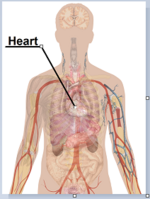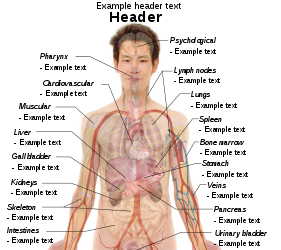Файл:Stem cell treatments.png

Исходный файл (2417 × 1983 пкс, размер файла: 1,38 МБ, MIME-тип: image/png)
Этот файл из на Викискладе и может использоваться в других проектах. Информация с его страницы описания приведена ниже.
Содержание
Краткое описание
| ОписаниеStem cell treatments.png |
English: Diseases and conditions where stem cell treatment is promising or emerging. (See Wikipedia:Stem cell#Treatments). Bone marrow transplantation is, as of 2009, the only established use of stem cells.
To discuss image, please see Template talk:Human body diagrams |
| Дата | |
| Источник | All used images are in public domain. |
| Автор | Mikael Häggström |
| Другие версии |
|
References
Diabetes, rheumatoid arthritis, Parkinson's, Alzheimer's disease, osteoarthritis:
- Cell Basics: What are the potential uses of human stem cells and the obstacles that must be overcome before these potential uses will be realized? archive copy at the Wayback Machine. In Stem Cell Information World Wide Web site. Bethesda, MD: National Institutes of Health, U.S. Department of Health and Human Services, 2009. cited Sunday, April 26, 2009
Stroke and traumatic brain injury repair:
- Stem Cells Tapped to Replenish Organs thescientist.com, Nov 2000. By Douglas Steinberg
Learning defects:
- ISRAEL21c > Israeli scientists reverse brain birth defects using stem cells December 25, 2008. (Researchers from the Hebrew University of Jerusalem-Hadassah Medical led by Prof. Joseph Yanai)
Spinal cord injury repair:
- Kang KS, Kim SW, Oh YH, et al (2005). "A 37-year-old spinal cord-injured female patient, transplanted of multipotent stem cells from human UC blood, with improved sensory perception and mobility, both functionally and morphologically: a case study". Cytotherapy 7 (4): 368–73. DOI:10.1080/14653240500238160. PMID 16162459.
Heart infarction:
- Strauer BE, Schannwell CM, Brehm M (April 2009). "Therapeutic potentials of stem cells in cardiac diseases". Minerva Cardioangiol 57 (2): 249–67. PMID 19274033.
Anti-cancer:
- Stem Cells Tapped to Replenish Organs thescientist.com, Nov 2000. By Douglas Steinberg
Baldness:
- Hair Cloning Nears Reality as Baldness Cure WebMD November 2004
Replace missing teeth:
- Yen AH, Sharpe PT (January 2008). "Stem cells and tooth tissue engineering". Cell Tissue Res. 331 (1): 359–72. DOI:10.1007/s00441-007-0467-6. PMID 17938970.
Repair hearing:
Restore vision:
Amyotrophic lateral sclerosis:
- Drs. Gearhart and Kerr of Johns Hopkins University. April 4, 2001 edition of JAMA (Vol. 285, 1691-1693)
Crohn's disease:
- Querida Anderson (2008-06-15). "Osiris Trumpets Its Adult Stem Cell Product". Genetic Engineering & Biotechnology News: 13. Mary Ann Liebert, Inc.. Retrieved on 2008-07-06. "(subtitle) Procymal is being developed in many indications, GvHD being the most advanced"
Wound healing:
- Gurtner GC, Callaghan, MJ and Longaker MT. 2007. Progress and potential for regenerative medicine. Annu. Rev. Med 58:299-312
Лицензирование
| Public domainPublic domainfalsefalse |
| Я, владелец авторских прав на это произведение, передаю его в общественное достояние. Это разрешение действует по всему миру. В некоторых странах это не может быть возможно юридически, в таком случае: Я даю право кому угодно использовать данное произведение в любых целях без каких-либо условий, за исключением таких условий, которые требуются по закону. |
Human body diagramsMain article at: Human body diagrams Template location:Template:Human body diagrams How to derive an imageDerive directly from raster image with organsThe raster (.png format) images below have most commonly used organs already included, and text and lines can be added in almost any graphics editor. This is the easiest method, but does not leave any room for customizing what organs are shown. Adding text and lines: Derive "from scratch"By this method, body diagrams can be derived by pasting organs into one of the "plain" body images shown below. This method requires a graphics editor that can handle transparent images, in order to avoid white squares around the organs when pasting onto the body image. Pictures of organs are found on the project's main page. These were originally adapted to fit the male shadow/silhouette.
Organs:
Derive by vector templateThe Vector templates below can be used to derive images with, for example, Inkscape. This is the method with the greatest potential. See Human body diagrams/Inkscape tutorial for a basic description in how to do this.
Examples of derived works
Licensing
|
Краткие подписи
Элементы, изображённые на этом файле
изображённый объект
27 апреля 2009
История файла
Нажмите на дату/время, чтобы увидеть версию файла от того времени.
| Дата/время | Миниатюра | Размеры | Участник | Примечание | |
|---|---|---|---|---|---|
| текущий | 13:25, 19 февраля 2012 |  | 2417 × 1983 (1,38 МБ) | Mikael Häggström | Updated |
| 07:48, 27 апреля 2009 |  | 729 × 598 (346 КБ) | Mikael Häggström | {{Information |Description={{en|1=g}} |Source=Own work by uploader |Author=Mikael Häggström |Date=g |Permission= |other_versions= }} <!--{{ImageUpload|full}}--> |
Использование файла
Нет страниц, использующих этот файл.
Глобальное использование файла
Данный файл используется в следующих вики:
- Использование в az.wikipedia.org
- Использование в ca.wikipedia.org
- Использование в en.wikipedia.org
- Использование в es.wikipedia.org
- Использование в hu.wikipedia.org
- Использование в vi.wikipedia.org
Метаданные
Файл содержит дополнительные данные, обычно добавляемые цифровыми камерами или сканерами. Если файл после создания редактировался, то некоторые параметры могут не соответствовать текущему изображению.
| Горизонтальное разрешение | 59,06 точек на сантиметр |
|---|---|
| Вертикальное разрешение | 59,06 точек на сантиметр |
| Программное обеспечение |
|
































